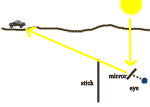 You’re in the middle of an easy 10-miler on a trail just outside of town. While up on little-used ridge top trail, you twist your ankle and snap your fibula. You get up and try to hobble down the trail, but the terrain is too technical for you to make worthwhile progress. Seeing as how you were only going for a short training run on local trails you left your cellphone and Spot Satellite Messenger (iRunFar discussion of Spot) at home, so you can’t contact a buddy for help. You’re also too far from town for any to hear you call for help and there’s little hope of another person being within earshot. What are you to do? Improvise an emergency signal mirror.
You’re in the middle of an easy 10-miler on a trail just outside of town. While up on little-used ridge top trail, you twist your ankle and snap your fibula. You get up and try to hobble down the trail, but the terrain is too technical for you to make worthwhile progress. Seeing as how you were only going for a short training run on local trails you left your cellphone and Spot Satellite Messenger (iRunFar discussion of Spot) at home, so you can’t contact a buddy for help. You’re also too far from town for any to hear you call for help and there’s little hope of another person being within earshot. What are you to do? Improvise an emergency signal mirror.
A proper emergency signal mirror can easily be seen for 10+ miles (there are reports of sightings from up to 100 miles) and can still be effective under overcast skies and even with bright moonlight. The principle behind an signal mirror is that a flash of light produced from the mirror will catch the eye of individuals, including search and rescue personnel. Signal mirrors are standard items for emergency kits, as well as mandatory gear for races such as the Marathon des Sables.
 When you need but don’t have an emergency signal mirror, one can be improvised. The face of a Garmin Forerunner 205 or 305 (available from Backcountry.com
When you need but don’t have an emergency signal mirror, one can be improvised. The face of a Garmin Forerunner 205 or 305 (available from Backcountry.com![]() ), the mirrored back of iPod, other highly reflective surfaces, or even broken glass will do. While true emergency signal mirrors generally have a built in sighting mechanism, aiming an improvised signal mirror takes a bit more skill. There are two techniques for aiming an improvised signal mirror (1) the hand method (picture at upper left) and (2) stick method (left). Rather than attempt to reinvent the wheel…. er, signal mirror, we’ll direct you to survival experts who ably explain the finer points of improvised signal mirror use:
), the mirrored back of iPod, other highly reflective surfaces, or even broken glass will do. While true emergency signal mirrors generally have a built in sighting mechanism, aiming an improvised signal mirror takes a bit more skill. There are two techniques for aiming an improvised signal mirror (1) the hand method (picture at upper left) and (2) stick method (left). Rather than attempt to reinvent the wheel…. er, signal mirror, we’ll direct you to survival experts who ably explain the finer points of improvised signal mirror use:
- Survival Topics’ Signaling Techniques – A simple, to-the-point description of how to aim a signal mirror. It is also the source of the two instructive images found in this post.
- SurvivalIQ‘s Means for Signaling – Discusses a wider range of signaling techniques, including fire and smoke, as well as alternate exemplary images of both the hand and stick signal mirror aiming techniques.
Please let other iRunFar readers know if you have or know of anyone how has made effective use of an emergency signal mirror – improvised or not. Please also share any insight or alternate resources on emergency signaling that you know.
iRunFar Survival Tips:
